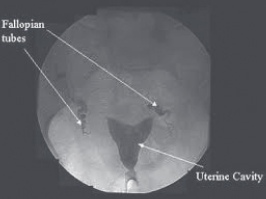Download and print as a PDF (234kB pdf)
On this page
What is a Hysterosalpingogram?
A Hysterosalpingogram (HSG) is a specialist x-ray examination looking at the anatomy of the uterus and fallopian tubes. An x-ray dye is used to visualise the area on x-rays.
An x-ray dye is used to highlight your uterus and fallopian tubes so we can see them on the x-ray.
When should I book my HSG?
The test needs to be performed between day one and day 14 of your menstrual cycle.
To make an appointment please telephone the department on the first day of your period.
The telephone number is below:
Imaging Department
Preparing for your HSG
It is very important that you follow the following instructions:
- You must not have sex from the start of your period (day one) until after the procedure.
- On the day of the appointment, collect a sample of your first urine (wee) of the morning and take the pregnancy test we have given you.
If the test is negative, come to your appointment as planned.
If the test is positive, do not attend your appointment, telephone us to let us know and then make an appointment with your local maternity services.
- You may bring someone to the department on the day of the appointment but they will not be able to be in the room during the examination. This is because we will be using x-rays for the exam. A nurse or healthcare assistant will be with you the whole time. They will look after you and hold your hand if you feel worried or uncomfortable.
- The whole appointment will take approximately 30 minutes.
What will happen during the examination?
The examination will be carried out by a team of staff including a radiologist, a radiographer, and a health care assistant.
You will be asked to change into a gown and will then be taken through to the imaging room. You may bring a dressing gown too if you wish.
Once in the room the x-ray doctor (radiologist) will explain the procedure in full and answer any questions you or your partner may have.
You will then lie on the x-ray table. To begin with the examination is like a smear test.
- A speculum will be placed into your vagina so that the doctor can see your cervix.
- Then a small plastic tube (catheter) will be positioned through your cervix, and a small balloon is inflated to hold this tube in place. You may experience cramping similar to period pain when this happens. (This usually passes as soon as the catheter is removed but if you wish, you may take a paracetamol before the examination or bring it for after the procedure).
- X-ray dye (clear fluid that shows on images) will then be gently introduced into your uterus, and this will also highlight your fallopian tubes. Several X-ray images will be taken then the tube and speculum will be removed.

What happens after the examination?
As soon as the procedure is finished you will be shown to a private toilet where you can wash and change and will be free to go.
The x-ray dye (contrast) may leak after the procedure so we will give you a sanitary towel but you might want to bring one of your own with you.
You will be given the results on the day of the examination and they will also be sent to your referring doctor.
We will give you an information sheet explaining about the aftercare for the procedure.
- You may experience some bleeding after your HSG. This should not be heavy or last for more than a few days.
- You may have sex after your HSG.
- You may have some dull pain. This should be no worse than a normal period. Please take your normal pain relief medication such as paracetamol if you need.
- If you develop an abnormal discharge from your vagina, bad pain, fevers or chills contact the Claude Nicol Clinic (number below), your GP or attend A&E after hours.
Claude Nicol Clinic
What are the risks and benefits?
As this procedure involves x-rays, there are the usual slight risks associated with ionising radiation. The amount of radiation we use is very small.
There is a less than 1 in 200 chance of developing a pelvic infection after the examination. This will be discussed in detail once you are in the x-ray room on the day of your appointment.
The benefits of having this procedure done outweigh the risk.
Are there any alternatives?
If you are unable to tolerate this procedure, your referring doctor will be informed and they can decide if you can have a different examination.
Who do I contact for more information?
If you have any further queries about your HSG, please feel free to ask questions on the day of your examination, or speak to your referring clinician.
If you have any queries after the examination, you can speak to an x-ray nurse, number below:
X-ray nurse
01273 696955
Ext. 64240
If you have vision, hearing, mobility or access issues, or have any questions, please contact the Imaging Department on the number below:
This information is intended for patients receiving care in Brighton & Hove or Haywards Heath.
The information here is for guidance purposes only and is in no way intended to replace professional clinical advice by a qualified practitioner.